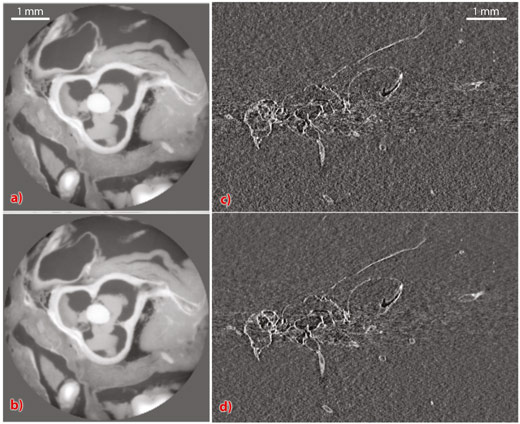- Home
- Users & Science
- Scientific Documentation
- ESRF Highlights
- ESRF Highlights 2012
- X-ray imaging
- Trimodal X-ray tomography with reduced dose
Trimodal X-ray tomography with reduced dose
Many areas of modern medicine, such as diagnosis, treatment planning, and fundamental research rely heavily on imaging techniques. However, the different methods currently used in medical imaging have their own limitations. Histological methods, for example, provide hardly any three-dimensional information. The most common 3-D methods, on the other hand, are limited either in soft-tissue contrast (conventional absorption X-ray imaging) or spatial resolution (magnetic resonance imaging).
A new X-ray imaging technique known as “grating interferometry” (XGI), which uses interactions between X-rays and matter other than absorption to obtain contrast, provides images with unprecedented density contrast and high spatial resolution of a few micrometres. The superb density sensitivity down to 0.5 mg/cm3 in the phase-contrast images obtained with XGI allows soft tissues with very tiny differences in composition to be discerned, see [1,2] and Figure 60. Moreover, XGI also yields the so-called “dark-field” signal, which reveals the presence of sub-pixel-size scattering structures in the object, such as fibres, cracks or nanosized pores.
 |
|
Fig. 60: Different sections through the phase tomogram of a rat testicle obtained with XGI. The epididymis is shown in blue and the adipose tissue is coloured yellow. Inside the testis, the seminiferous tubules and the vessels (in dark red) are clearly visible. |
Depending on the properties of the source, the interferometer consists of two or three line grids with high aspect ratios and periods of a few micrometres. One of these gratings is scanned transversally to obtain the different image signals [2]. An important advantage of this method over other phase-contrast X-ray techniques is that XGI also performs well for low-brilliance laboratory sources. The possibility of transferring this technique to clinical practice is under investigation in Europe and Japan, where prototypes of small animal scanners and preclinical machines using XGI are being developed.
One of the main challenges when irradiating patients with X-rays is to keep the radiation dose low. We have made an important step forward in optimising the application potential of this technique. The high-performance grating interferometer used in this study has been installed at beamline ID19.
Our development consists of a new measurement protocol for XGI-based tomography called the “sliding window” technique. Through simultaneous grating stepping and sample rotation, combined with advanced data analysis, phase and dark-field images of a given quality can be obtained faster and with much less dose than before. Moreover, this new protocol makes XGI compatible with continuous tomographic scans, in which the rotation of the detector and source relative to the sample does not stop or slow down as images are acquired. This mode is employed in most medical tomography scanners, unlike the stop-and-go mode used so far in XGI tomography.
The sliding window method has been demonstrated with simulations and experimental data collected at ID19. In Figure 61 images taken with the sliding-window method are compared to images obtained with the standard procedure. The pictures on the left show phase tomography slices of a mouse heart; the aortic valve is clearly visible at the centre of these images. Figure 61a was obtained with the standard procedure, Figure 61b with the sliding window method and 5 times less dose. Thanks to the advantages of the new protocol, these two images show very similar quality despite the large difference in dose. Figure 61c and Figure 61d show dark-field slices of a wasp in amber, obtained with the standard and the sliding-window methods, respectively. These two tomograms were obtained with the same radiation dose delivered to the sample. Their comparison demonstrates that the new method can significantly reduce image noise. It should also be noticed that the wing of the animal, corresponding to a small crack in the amber that is almost invisible in absorption as well as phase contrast, can be clearly revealed with the dark-field signal.
The complementarity of the image signals accessed with X-ray grating interferometry and the new simple and fast acquisition procedure make X-ray grating interferometry an attractive technique for high-sensitivity biomedical imaging and possibly also for future hospital CT scanners. The potential of this method should also be further investigated for materials science and palaeontology.
Principal publication and authors
I. Zanette (a, b), M. Bech (b), A. Rack (a), G. Le Duc (a), P. Tafforeau (a), C. David (c), J. Mohr (d), F. Pfeiffer (b) and T. Weitkamp (e), Proc. Natl. Acad. Sci. USA 109, 10199–10204 (2012).
(a) ESRF
(b) Department of Physics and Institute for Medical Engineering, Technische Universität München, Garching (Germany)
(c) Laboratory for Micro- and Nanotechonology, Paul Scherrer Institut, Villigen (Switzerland)
(d) Karlsruhe Institute of Technology, Institute for Microstructure Technology, Karlsruhe (Germany)
(e) Synchrotron Soleil, Gif-sur-Yvette (France)
References
[1] G. Schulz, C. Waschkies, F. Pfeiffer, I. Zanette, T. Weitkamp, C. David and B. Müller, Scientific Reports, 2, 826 (2012).
[2] I. Zanette, M. Bech, F. Pfeiffer and T. Weitkamp, Applied Physics Letters 98, 094101 (2011).




